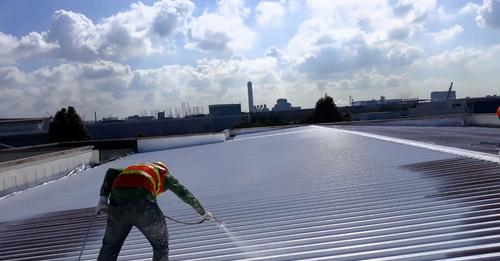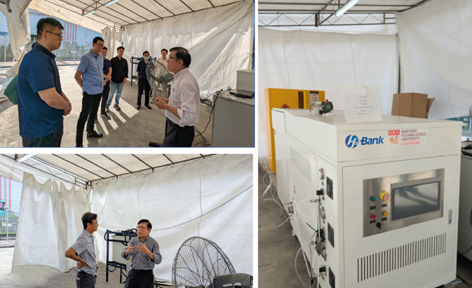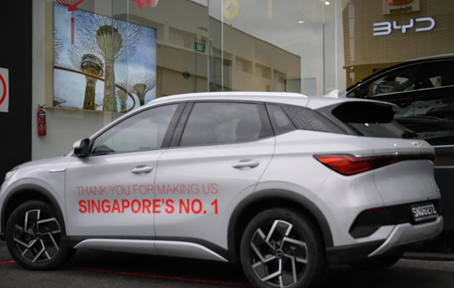First published online at The Straits Times

The NTU team coated the roofs, walls and a road of an industrial area with cool paint for the trial. PHOTO: NTU
SINGAPORE – The use of a reflective paint coating to cool down the urban environment will be piloted by industrial developer JTC at buildings in Bukit Batok and Sin Ming.
The trial, targeted to begin in the third quarter of 2024, adds to ongoing efforts in recent years to bring down city heat by coating building facades with cool paint.
Bukit Batok Industrial Park A and Sin Ming Industrial Estate will be coated in cool paint to see if it is effective in alleviating the urban heat island effect, said JTC. The effect refers to how urban areas feel warmer than rural areas due to roads, buildings and vehicles absorbing and retaining heat.
This follows an earlier experiment at a western JTC industrial area by Nanyang Technological University (NTU) researchers that showed the painted environment was up to 2 deg C cooler during the hottest times of the day. Findings of the experiment, which was done in 2018 and 2019, were published in the journal Sustainable Cities and Society in March 2024.
Separately in 2020, NTU also tested the use of cool paint at two Housing Board blocks in Bukit Purmei, before HDB expanded its use to 130 blocks in Tampines in a study expected to wrap up in 2024.
In the NTU experiment done between 2018 and 2019, two industrial buildings under JTC and the road between them were coated with the cool paint, while another two buildings in the area served as controls. The paint contained titanium dioxide, a pigment that is good at reflecting sunlight and is commonly used in sunscreen.
The NTU team, led by Associate Professor Wan Man Pun at the School of Mechanical and Aerospace Engineering, monitored conditions such as air movement, surface and air temperature, humidity and radiation at both sites over six months.
About 30 per cent less heat was released from the painted buildings and pavements, cooling the area’s temperature by up to 2 deg C during the hottest time of the day at around 4pm. Pedestrians would feel 1.5 deg C cooler in that outdoor environment, according to measurements using the Universal Thermal Climate Index.
Utilising green spaces and water features like ponds and lakes is a more familiar approach to cool cities, but this requires integration into urban planning.
“The convenience of cool paint is that you don’t need any redevelopment. You just paint on existing infrastructure,” Prof Wan said.
The researchers are formulating a more effective paint that uses barium sulphate pigment. This chemical can reflect more of the sun’s heat, which a building could have absorbed, back into outer space.
The next-generation paint also contains a polymer binder that emits heat through wavelengths called the atmospheric window, said Assistant Professor Ng Bing Feng, a co-author of the study, who is also from the School of Mechanical and Aerospace Engineering. This means that the reflected heat will not linger in the surroundings, providing a greater cooling effect.
About 30 per cent less heat was released from the painted buildings and pavements, cooling the area’s temperature by up to 2 deg C during the hottest time of the day at around 4pm. Pedestrians would feel 1.5 deg C cooler in that outdoor environment, according to measurements using the Universal Thermal Climate Index.
Utilising green spaces and water features like ponds and lakes is a more familiar approach to cool cities, but this requires integration into urban planning.
“The convenience of cool paint is that you don’t need any redevelopment. You just paint on existing infrastructure,” Prof Wan said.
The researchers are formulating a more effective paint that uses barium sulphate pigment. This chemical can reflect more of the sun’s heat, which a building could have absorbed, back into outer space.
The next-generation paint also contains a polymer binder that emits heat through wavelengths called the atmospheric window, said Assistant Professor Ng Bing Feng, a co-author of the study, who is also from the School of Mechanical and Aerospace Engineering. This means that the reflected heat will not linger in the surroundings, providing a greater cooling effect.
Pavements of an industrial area coated with the cool paint. PHOTO: NTU
Cool paint can also reduce the energy consumption of air-conditioning in buildings, noted Prof Wan. The release of waste heat from air-conditioners contributes to the urban heat island effect.
As heat is released at night, the man-made phenomenon – which exacerbates global warming – can raise temperatures by 4 deg C to 7 deg C in urban areas here, according to the Cooling Singapore research project.
On top of using the special paint, cooling down an entire city requires a suite of technologies and measures, said Prof Wan.
“Cool paint can deal with only the absorption of solar radiation. A city heats up because of many factors like our daily activities, traffic and manufacturing,” he added.
The NTU team monitored the environmental conditions at the test sites for over six months to see how well the cool paint coatings worked in reducing city heat. PHOTO: NTU
As cool paint is a recent entrant here, it is costlier compared with ordinary paint, said Prof Wan, who declined to go into the prices. In more mature markets such as California – where new and renovated roofs must use cooler materials, including cool paint – the price difference is more negligible.
Mr Joseph Goh, vice-president of the Institution of Engineers, Singapore, said: “To encourage wider adoption, it may not be wise to use cool paint on all surfaces due to the high costs.”
He noted that applying cool paint on pavements would be costlier than applying it on building facades. “If there are regulations to deal with urban heat through the use of greenery, shades or cool paint, there may be greater adoption (of these methods) and lower costs due to economies of scale.”










